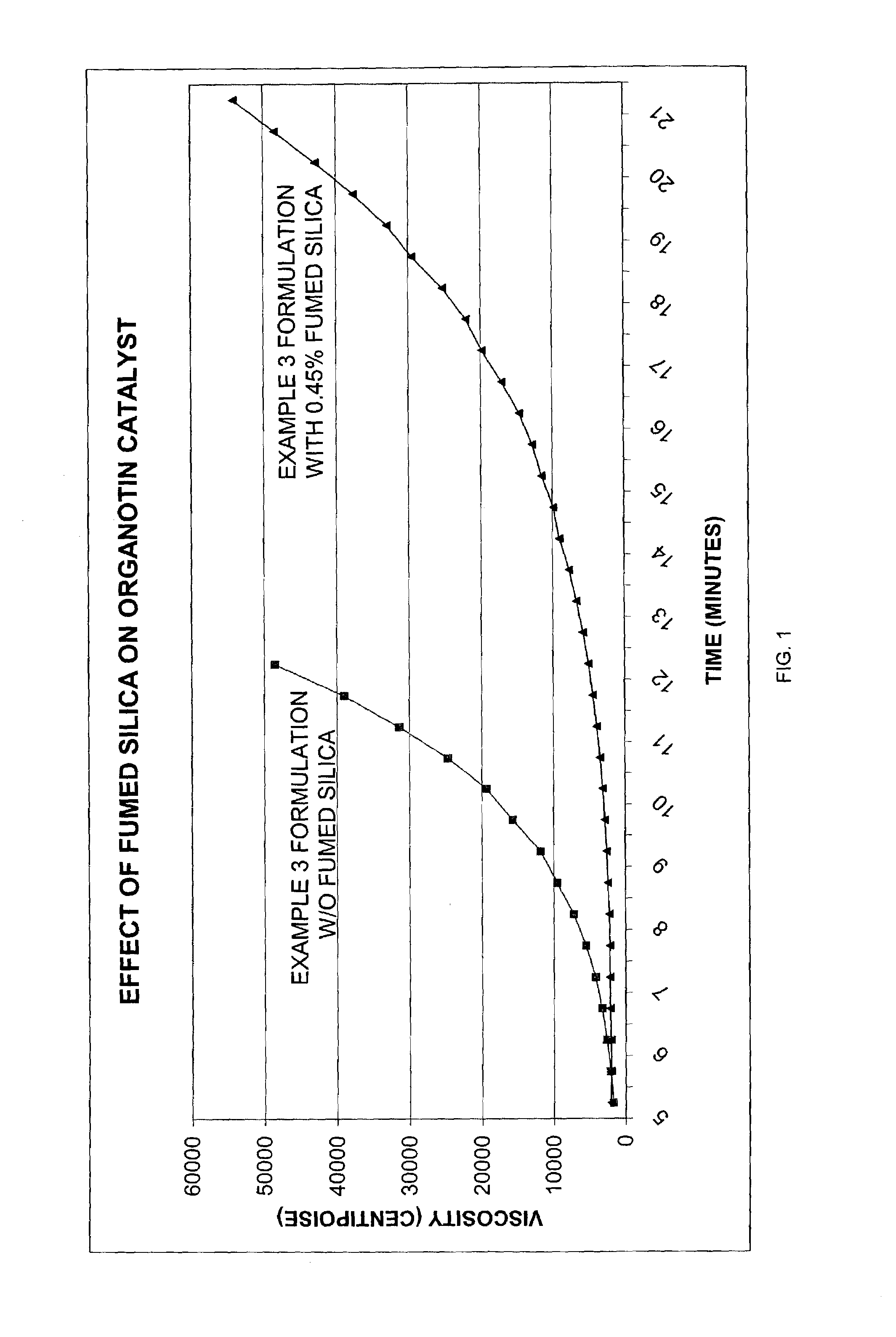Polyurethane system and application thereof
a polyurethane and surface technology, applied in the field of polyurethane surface, can solve the problem that the system has not been formulated to address all of these problems
- Summary
- Abstract
- Description
- Claims
- Application Information
AI Technical Summary
Problems solved by technology
Method used
Image
Examples
example 1
A Component:
[0024]
Polyether diol, avg. M.W. of 200025.05 wt % Polyether triol, approx. 240 mg KOH / g3.78 wt %Dipropylene glycol8.32 wt %Ricinus oil18.90 wt % Barium Sulfate15.12 wt % Calcium Carbonate19.66 wt % Iron Oxide2.45 wt %Fluorosurfactant0.05 wt %Organotin catalyst0.02 wt %Iron acetylacetonate0.02 wt %Phthalate of C7–C11 alcohols3.78 wt %Molecular sieve1.25 wt %Polysiloxane0.30 wt %Hindered amine UV Stabilizer0.80 wt %Fumed silica0.50 wt %
B Component:
[0025]
Modified diphenylmethane 4,4′-diisocyanate20.00 wt %High 2,4 isomer blend of diphenylmethane diisocyanate26.00 wt %Polyether diol, avg. M.W. of 200054.00 wt %
[0026]The A component and B component of Example 1 were mixed at a 1:1 volume ratio and allowed to cure at 75° F. The resulting polyurethane surface exhibited a gel time of 18 minutes and a sufficient cure time for an athletic surface application.
example 2
[0027]The polyurethane formulation of Example 1 was compared to a similar formulation that did not contain fumed silica. Both two-component systems were mixed and allowed to cure at 75° F. The formulation that did not contain fumed silica exhibited a gel time of 7 minutes, 35 seconds. The formulation containing fumed silica exhibited a 237% increase in gel time without significantly effecting cure response for an athletic surface application.
example 3
A Component:
[0028]
Polyether diol, avg. M.W. of 200019.07 wt % Dipropylene glycol7.50 wt %Ricinus oil28.16 wt % Barium Sulfate37.58 wt % Iron Oxide2.33 wt %Organotin catalyst0.03 wt %Fluorosilicone0.90 wt %2,2,4-trimethyl-1,3-pentanediol diisobutyrate1.21 wt %Molecular sieve1.18 wt %Polysiloxane0.50 wt %Hindered amine UV Stabilizer0.75 wt %Fumed silica0.79 wt %
B Component:
[0029]
High 2,4 isomer blend of diphenylmethane diisocyanate18.87 wt %Polyether diol, avg. M.W. of 200051.03 wt %Polymeric dimethylene diisocyanate30.00 wt %Fluorosilicone 0.10 wt %
[0030]The A component and B component of Example 3 were mixed at a 1:1 volume ratio and allowed to cure at 75° F. During the cure, a viscometer was employed to measure the rate of reaction. The data obtained is illustrated in FIG. 1 and shows the reaction delaying properties of fumed silica. An air release agent was added to the B component, which is formulated as a prepolymer, to improve dispersion of the 2,4 isomer blend and the polymeri...
PUM
| Property | Measurement | Unit |
|---|---|---|
| gel time | aaaaa | aaaaa |
| temperatures | aaaaa | aaaaa |
| tensile strengths | aaaaa | aaaaa |
Abstract
Description
Claims
Application Information
 Login to View More
Login to View More - R&D
- Intellectual Property
- Life Sciences
- Materials
- Tech Scout
- Unparalleled Data Quality
- Higher Quality Content
- 60% Fewer Hallucinations
Browse by: Latest US Patents, China's latest patents, Technical Efficacy Thesaurus, Application Domain, Technology Topic, Popular Technical Reports.
© 2025 PatSnap. All rights reserved.Legal|Privacy policy|Modern Slavery Act Transparency Statement|Sitemap|About US| Contact US: help@patsnap.com


